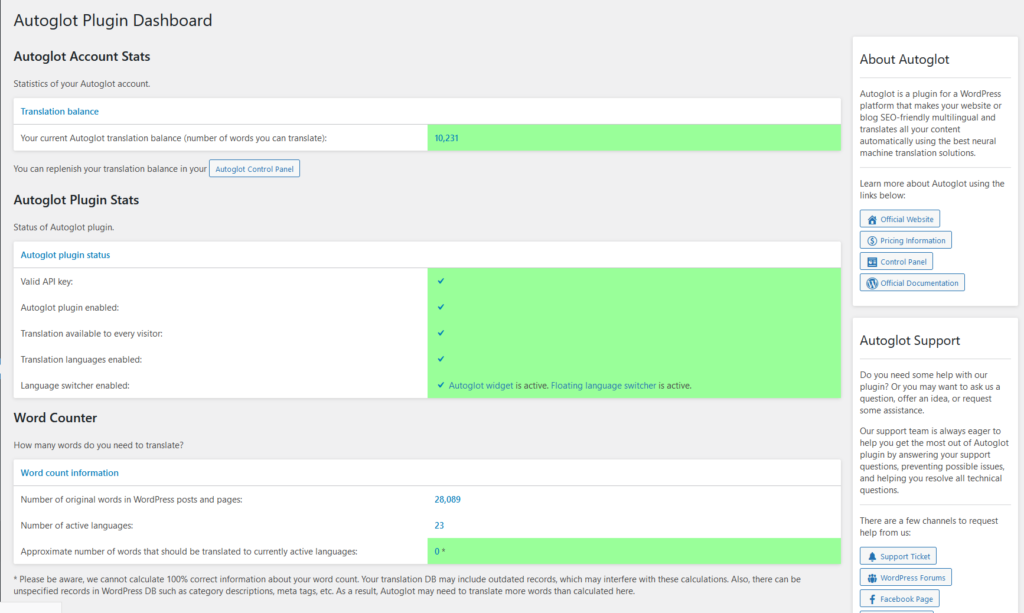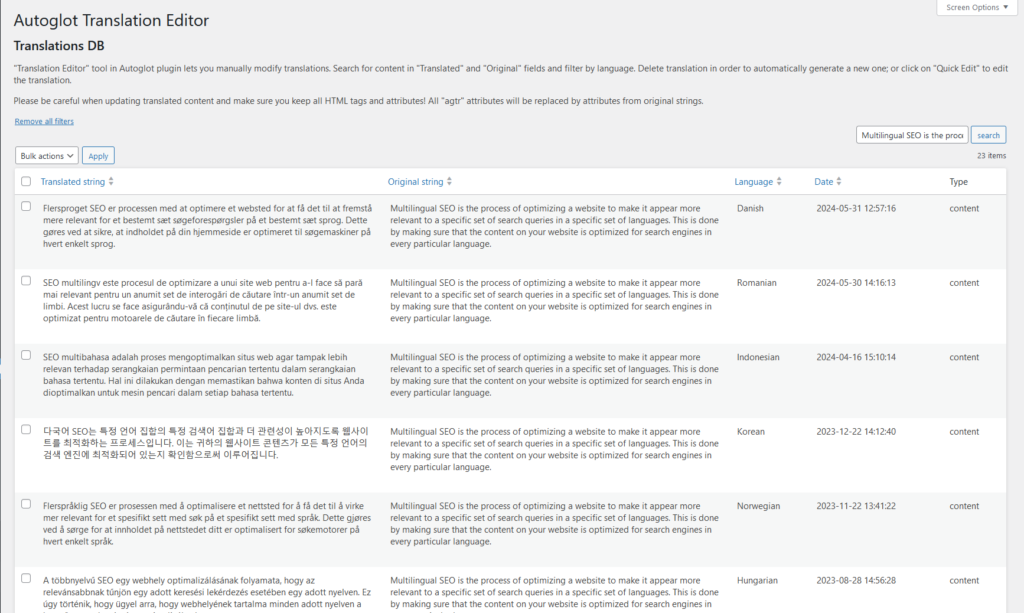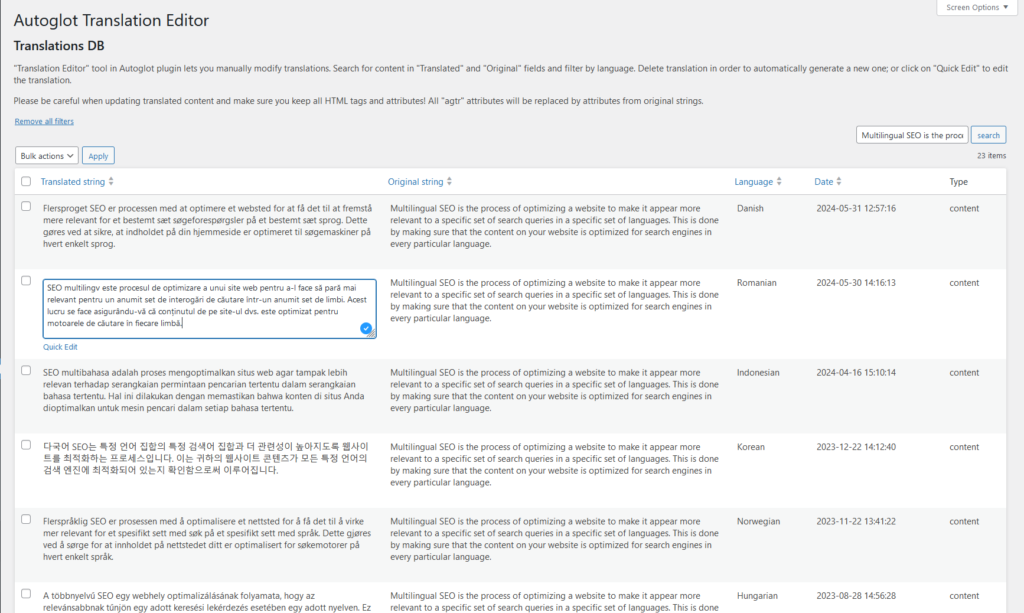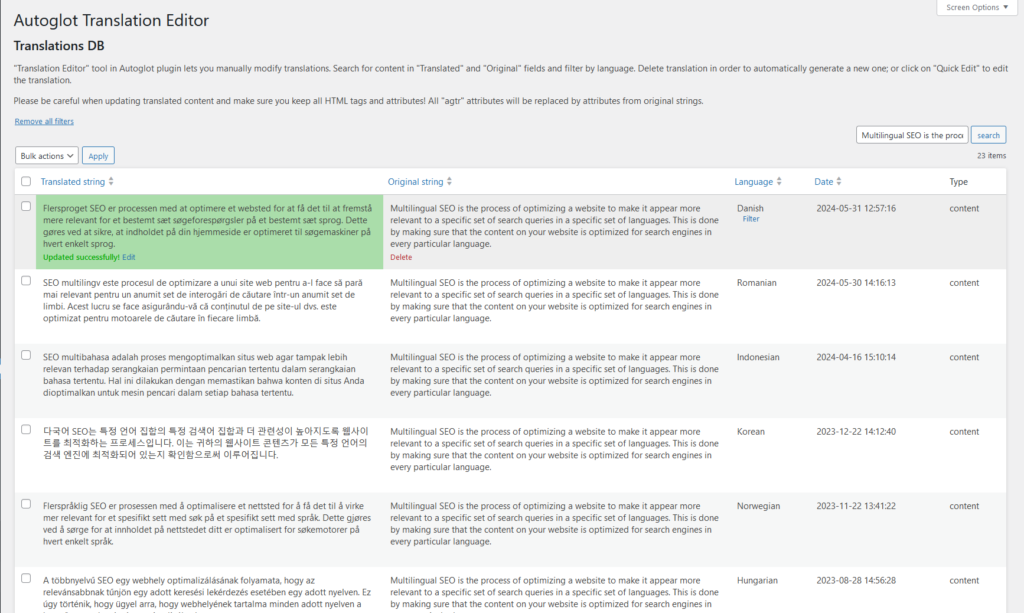
Көп тилдүү веб-сайттар дүйнөлүк аудиторияга жетүү үчүн абдан маанилүү. Бүгүнкү өз ара байланышта болгон дүйнөдө, бир нече тилде сүйлөгөндөрдү тейлеген веб-сайтка ээ болуу сиздин мүмкүнчүлүктү кыйла кеңейтет. Ар кандай тилдердеги мазмунду сунуштоо менен, сиз англис тилин билбегендерди жөн эле кабыл албастан, аларды брендиңиз менен иштешүүгө активдүү чакырасыз. Бул камтуу ар кандай географиялык аймактардан келген трафиктин олуттуу өсүшүнө алып келиши мүмкүн, бул сиздин бизнесиңизге жаңы рынокторго жана демографияга кирүүгө мүмкүндүк берет.
Киришүү
Көп тилдүү веб-сайттарга сереп салуу
Бул макала WordPress'те котормолорду оңдоо процесси аркылуу сизге тууралоодон кийинки ыкмаларды колдонуу менен жетекчилик кылууга багытталган. Көп тилдүү веб-сайттарга суроо-талап өскөн сайын так жана ишенимдүү котормолорго болгон муктаждык да өсүүдө. Машиналык котормо мазмунду тез которууну жеңилдеткени менен, котормолордун так жана контекстке ылайыктуулугун камсыз кылуу үчүн көп учурда тактоону талап кылат. Автоматташтырылган котормо менен адамдык сапат стандарттарынын ортосундагы ажырымды жоюп, пост-редакциялоо мына ушул жерде ишке ашат.
Бул колдонмо оңдоодон кийинки машиналык котормолордун артыкчылыктарын жана бул ыкма сиздин көп тилдүү веб-сайтыңызды кантип жакшыртаарын изилдейт. Котормоңуздун сапатын жакшыртуу менен, сиз жакшыраак колдонуучу тажрыйбасын камсыздай аласыз, аудиторияңыздын ишенимин арттырып, акыр аягында көбүрөөк трафикти жана конверсияларды камсыздай аласыз.
Жогорку сапаттагы котормолордун маанилүүлүгүн түшүнүү
Жогорку сапаттагы котормолордун маанилүүлүгүн түшүнүү жана аларга кантип жетүүнү үйрөнүү сизге атаандаштык артыкчылык берет. Көп тилдүү веб-сайттардын баалуулугун көбүрөөк бизнес тааныган сайын, сапаттуу котормолорго инвестиция салгандар өзгөчөлөнөт. Бул колдонмо сизге веб-сайтыңыздын котормолорун өркүндөтүү боюнча практикалык кадамдарды жана кеңештерди берет, алар глобалдык аудиторияңыздын муктаждыктарына жана күтүүлөрүнө жооп берет.
Вебсайттын администратору, котормочу же корректор болобу, бул колдонмо сизге сайтыңыздын көп тилдүү мазмунун жакшыртууга жана кеңири аудиторияга ишенимдүүлүк менен жетүүгө жардам берет.
Ар түрдүү аудиторияга кантип жетүүгө болот?
Көп тилдүү веб-сайттардын артыкчылыктары
Жаңы аудиторияга жетүү
Көп тилдүү веб-сайттар бизнеске англис тилин билбеген кардарлар менен байланышууга мүмкүнчүлүк берет. Интернет - бул глобалдык платформа, жана көптөгөн колдонуучулар өздөрүнүн эне тилиндеги мазмунду жактырышат же талап кылышат. Веб-сайтыңызда көп тилдүү опцияларды камсыз кылуу менен, сиз кеңири аудитория менен, анын ичинде тилдик тоскоолдуктардан улам алынып салынган аудитория менен катыша аласыз. Бул кошулуу жаңы рынокторду ачып, бизнесиңизге эл аралык деңгээлде кардарлар базасын өстүрүүгө мүмкүндүк берет.
Дүйнөлүк трафикти айдоо
Бир нече тилде мазмунду сунуштоо сиздин сайттын глобалдык трафигин олуттуу жогорулатат. Издөө системалары ар кандай тилдик топтордун муктаждыктарына жооп берген мазмунга артыкчылык беришет. Вебсайтыңыз котормолорду камтыса, ал ошол тилдер боюнча издөө натыйжаларында көбүрөөк көрүнүп, ар кайсы өлкөлөрдөн жогорку органикалык трафикке алып келет. Бул көбөйгөн көрүнөө көбүрөөк конокторду, жогорку тартуу чендерди жана жакшыртылган SEO рейтингин алып келиши мүмкүн.
Жакшыртылган колдонуучу тажрыйбасы
Көп тилдүү веб-сайт колдонуучунун канааттануусун жана катышуусун жогорулатат. Коноктор көбүрөөк убакытка калып, алар каалаган тилде баарлашкан сайт менен көбүрөөк иштешет. Бул ыңгайлуулук жана жетүү жөнөкөйлүгү, жакшыраак колдонуучу тажрыйбасына, жогорку кармап калуу ченине жана конверсиянын көбөйүшүнө алып келиши мүмкүн. Бир нече тилде мазмунду берүү аудиторияңыз менен бекем байланышты бекемдеп, ар түрдүү маданий тектерди сыйлоону жана түшүнүүнү көрсөтөт.
Атаандаштык артыкчылык
Көп тилдүү веб-сайтка ээ болуу сизге дүйнөлүк рынокто атаандаштыкка жөндөмдүүлүк берет. Көптөгөн ишканалар дагы эле бир тилдүү веб-сайттар менен иштешет, бул алардын жеткиликтүүлүгүн чектейт. Көп тилдүү мазмунду сунуштоо менен сиз бул тенденцияга ыңгайлаша элек атаандаштардан өзгөчөлөнөсүз. Бул дифференциация өз эне тилиндеги маалыматка жетүү мүмкүнчүлүгүн баалаган кардарларды тартууда жана кармап калууда чечүүчү мааниге ээ болушу мүмкүн.
Жакшыртылган бренд сүрөтү
Көп тилдүү веб-сайттар бренддин позитивдүү жана инклюзивдүү имиджин түзүүгө салым кошот. Дүйнөлүк аудиторияны тейлөө боюнча милдеттенмени көрсөтүү сиздин брендиңизди жакшы чагылдырып, алдыга умтулган жана инклюзивдүү экениңизди көрсөтөт. Бул сиздин репутацияңызды жогорулатып, эл аралык кардарлар менен ишенимди арттырып, бренддин лоялдуулугун арттырат.
Дүйнөлүк аудиторияга жетүүнү кеңейтүү киреше мүмкүнчүлүктөрүн жогорулатууга алып келет. Эл аралык рынокко чыгуу менен сиз көбүрөөк кардарларды тартып, сатууну көбөйтө аласыз. Көп тилдүү веб-сайттар ар кайсы аймактардан келген колдонуучуларга сиздин өнүмдөрүңүздү же кызматтарыңызды түшүнүүнү жеңилдетет, бул көбүрөөк конверсияга жана акыр аягында көбүрөөк кирешеге алып келиши мүмкүн.
Кантип ийгиликтүү көп тилдүү бизнести онлайн ачуу керек?
Машина котормонун пост-редакциялоонун мааниси
Сапатты жогорулатуу
Пост-редакциялоо машиналык котормолордун тактыгын жана эркиндигин бир топ жакшыртат. Машина котормолору тез жана үнөмдүү болгону менен, көп учурда адам котормочу алып келе турган нюанстарды түшүнбөйт. Алар ыңгайсыз фразаларды, грамматикалык каталарды жана контексттик так эместиктерди жаратышы мүмкүн. Бул котормолорду карап чыгуу жана тактоо үчүн адамдык редакторду тартуу менен, сиз мазмундун туура гана эмес, табигый түрдө окулушун жана көздөлгөн маанини так жеткирүүсүн камсыздай аласыз.
Ылдамдык менен сапатты тең салмактоо
Пост-редакциялоо машина котормосунун ылдамдыгы менен адамдын котормосунун сапатынын ортосундагы балансты сунуштайт. Таза машиналык котормо тез, бирок көп учурда ишенимсиз, ал эми толук адам которуу так, бирок көп убакытты жана кымбатты талап кылат. Пост-редакциялоо эки дүйнөнүн эң мыктысын бириктирип, машиналык котормодо алгач оор жүктөрдү көтөрүүгө мүмкүндүк берет, андан кийин текстти жылтыратууга адамдын кийлигишүүсү. Бул ыкма толук адам котормосу менен салыштырганда убакытты жана чыгымды бир топ кыскартат, ошол эле учурда сапаттын жогорку стандартына жетишет.
Экономикалык эффективдүүлүк
Пост-редакциялоо нөлдөн баштап кол менен которууга караганда алда канча жеткиликтүү чечим болуп саналат. Ар бир мазмун үчүн профессионал котормочуларды жалдоо кымбатка турса да, машиналык котормону колдонуу, андан кийин адамдык пост-редакциялоо үнөмдүү альтернатива сунуштайт. Бул ыкма технологиянын натыйжалуулугун жогорулатат, ошол эле учурда акыркы продукт сапат стандарттарына жооп берет, бул бюджеттик чектөөлөр бар ишканалар үчүн идеалдуу чечим болуп саналат.
ырааттуулук
Пост-редакциялоо сиздин мазмунуңуз боюнча терминологияны жана стилди ырааттуу колдонууну камсыз кылат. Машина котормо системалары кээде карама-каршы болушу мүмкүн, айрыкча атайын терминологияга же брендге тиешелүү тилге. Адамдык редактор бардык тилдерде брендиңиздин үнүнүн бүтүндүгүн сактап, терминдердин ырааттуу жана туура колдонулушун камсыздай алат.
Ийкемдүүлүк жана масштабдуулук
Пост-редакциялоо оңой жаңыртууларды жана масштабдуулукту камсыз кылат. Мазмунуңузду жаңыртышыңыз керек болгондо, машиналык котормо тез арада жаңы версияны камсыздай алат жана адамдык редактор керектүү оңдоолорду жасай алат. Бул ийкемдүүлүк тез-тез жаңыртууларды талап кылган же которуу үчүн мазмундун чоң көлөмүнө ээ веб-сайттар үчүн өзгөчө баалуу. Бул сапатты бузбастан, тез масштабдоону камсыз кылат.
Колдонуучунун тажрыйбасын жогорулатуу
Жогорку сапаттагы котормолор жалпы колдонуучу тажрыйбасын жакшыртат. Начар которулган мазмун колдонуучуларды чаташтырат жана капа кылып, веб-сайтыңызга жана брендиңизге терс таасир тийгизиши мүмкүн. Котормолоруңуздун так жана жакшы жазылганын пост-редакциялоо аркылуу камсыз кылуу менен, сиз колдонуучуларыңызга жылмакай жана жагымдуу тажрыйбаны камсыздайсыз, аларды мазмунуңузга көбүрөөк катышууга үндөйсүз жана конверсиялардын ыктымалдуулугун жогорулатасыз.
Машина котормосунун артыкчылыктары Пост-редакциялоо
- Пост-редакциялоо нөлдөн которууга караганда кыйла тезирээк. Баштапкы долбоорду түзүү үчүн машина котормосун колдонуу менен, адамдык редакторлор нөлдөн баштап эмес, мазмунду тактоого жана оңдоого аракет кыла алышат. Бул жөнөкөйлөштүрүлгөн процесс убакытты үнөмдөп, которулган мазмунду тезирээк бүтүрүү убакыттарын камсыз кылат, бул өзгөчө мөөнөттөрү тар ишканалар үчүн пайдалуу.
- Пост-редакция терминологияны жана стилди ырааттуу колдонууну камсыз кылат. Машина котормо системалары кээде ырааттуулукту сактоо менен күрөшүп калышы мүмкүн, айрыкча тармакка тиешелүү жаргондор же брендге тиешелүү тил менен иштөөдө. Адамдык редакторлор терминологияны стандартташтыра алат жана котормо сиздин брендиңиздин үнүнө жана стилиңизге шайкеш келишин камсыздай алат, бул ырааттуу жана профессионалдуу акыркы продуктуну камсыз кылат.
- Пост-редакциялоо толук кол менен которууга салыштырмалуу үнөмдүү чечим болуп саналат. Нөлдөн баштап мазмунду түзүү үчүн профессионал котормочуларды жалдоо кымбатка турса да, машиналык котормо, андан кийин редакциялоо бюджетке ылайыктуу альтернатива сунуштайт. Бул ыкма ишканаларга кол менен которууга байланышкан олуттуу чыгымдарсыз жогорку сапаттагы котормолорду чыгарууга мүмкүндүк берет, бул чектелген бюджети бар компаниялар үчүн идеалдуу вариант.
- Пост-редакция мазмунду жаңыртуу жана сактоо үчүн ийкемдүүлүктү камсыз кылат. Вебсайтыңыз өнүгүп, жаңы мазмун кошулган сайын, машиналык котормо тез арада адам редакторлору тактай турган котормолорду түзө алат. Бул ийкемдүүлүк тез-тез жаңыртууларды талап кылган же чоң көлөмдөгү мазмунду башкарган веб-сайттар үчүн өзгөчө баалуу болуп, көп тилдүү мазмунуңуздун актуалдуу жана так болушун камсыз кылат.
- Пост-редакция котормо аракеттерин тез масштабдоого мүмкүндүк берет. Жаңы рынокторго өз таасирин кеңейтүүнү көздөгөн бизнес үчүн чоң көлөмдөгү мазмунду тез жана натыйжалуу которуу жөндөмдүүлүгү өтө маанилүү. Машина котормосун адамдын пост-редакциясы менен айкалыштыруу менен компаниялар сапатты бузбастан өсүп жаткан талаптарды канааттандыруу үчүн котормо аракеттерин кеңейте алышат.
- Жогорку сапаттагы котормолор колдонуучу тажрыйбасын жакшыртат жана ишенимди бекемдейт. Колдонуучулар так жана эркин которулган мазмунга көбүрөөк тартылышат. Начар котормолор конокторду капа кылып, алыстатып, брендиңиздин терс таасирине алып келиши мүмкүн. Котормолоруңуздун оңдоп-түзөөдөн кийин жылмакай жана профессионалдуу болушун камсыз кылуу менен, сиз жакшыраак колдонуучу тажрыйбасын камсыз кылып, аудиторияңыздын ишенимин арттырып, кайталап барууларды жана конверсияларды кубаттай аласыз.
- Пост-редакциялоо бизнеске дүйнөлүк рынокто атаандаштык артыкчылык берет. Көптөгөн компаниялар көп тилдүү веб-сайттардын маанилүүлүгүн түшүнгөн сайын, жогорку сапаттагы котормолорго инвестиция салгандар өзгөчөлөнөт. Жакшы которулган мазмунду сунуштоо эл аралык кардарларга берилгендикти көрсөтүп, брендиңиздин репутациясын жогорулатып, котормо сапатына артыкчылык бербеген атаандаштардан артыкчылыкка ээ болууга жардам берет.
Autoglot аркылуу WordPressте котормолорду түзөтүү боюнча колдонмо
1-кадам: WordPress администратор панелине кирүү
Биринчиден, WordPress администратор панелиңизге кириңиз. Бул жерде сиз веб-сайтыңыздын бардык функцияларына кире аласыз. Плагиндерди жана котормолорду башкаруу үчүн керектүү уруксаттарыңыз бар экенин текшериңиз.

Autoglot плагинине өтүңүз. Киргенден кийин, менюдан Autoglot плагинди табыңыз. Плагиндин негизги интерфейсин ачуу үчүн аны басыңыз, анда ар кандай котормо башкаруу функцияларына кире аласыз.
2-кадам: Котормо редакторуна кириңиз
Autoglot плагининин ичиндеги Котормо редакторуна өтүңүз. Котормо редактору - бул сиздин сайтыңыздын котормолорун башкаруу борбору. Бул жерде сиз маалымат базасында сакталган бардык котормо жазууларынын толук тизмесин көрөсүз.

Издөө жана чыпкалоо функцияларын колдонуңуз. Котормо редактору ыңгайлуу издөөнү жана тил функциялары боюнча чыпкалоону камтыйт. Бул куралдар белгилүү котормо саптарын тез табууга жардам берип, чоң көлөмдөгү мазмунду натыйжалуу башкарууну жеңилдетет.
3-кадам: Котормо жазууларын жок кылуу
Котормо жазууларын жок кылуу мүмкүнчүлүгү бар. Эгер сиз туура эмес же эскирген котормолорду тапсаңыз, бул жазууларды жок кылсаңыз болот. Бул сиздин мазмунуңуздун так жана актуалдуу бойдон калышын камсыз кылуу үчүн системаны жаңы котормолорду калыбына келтирүүгө түрткү берет.
4-кадам: Ыкчам өзгөртүү функциясын колдонуңуз
Эң негизги өзгөчөлүк - бул Quick Edit баскычы. Бул баскыч сайттын администраторлоруна, котормочуларга же корректорлорго котормолорду түздөн-түз кол менен тууралоо жана өзгөртүү мүмкүнчүлүгүн берет. Ыкчам түзөтүүнү чыкылдатуу менен, котормо текстине дароо өзгөртүүлөрдү киргизип, тактыкты жана контексттик актуалдуулукту жогорулата аласыз.

Кол менен тууралоо жана зарыл болгон котормолорду өзгөртүү. Ыкчам түзөтүү өзгөчөлүгү котормолорду тактоо үчүн жөнөкөй жолду камсыздайт, алар сиздин сапат стандарттарыңызга жооп берет жана арналган кабарды так чагылдырат.
5-кадам: Карап чыгуу жана жыйынтыктоо
Түзөткөндөн кийин, Autoglot өзгөртүүлөрүңүздү автоматтык түрдө сактайт. Бул кадам сиздин өзгөртүүлөрүңүздүн жандуу сайтка колдонулушун камсыз кылуу үчүн абдан маанилүү. Сактоодон мурун алардын так жана контекстке ылайыктуулугун текшерүү үчүн түзөтүлгөн котормолорду эки жолу текшериңиз.

Ырааттуулукту жана тактыкты камсыз кылуу үчүн акыркы котормолорду карап чыгыңыз. Сайтыңыздын жалпы тилине жана обонуна шайкеш келүү үчүн бардык түзөтүлгөн котормолорду карап чыгуу жакшы практика. Керек болсо акыркы оңдоолорду киргизиңиз.
Кылдат текшерүү жүргүзүү менен котормо процессин жыйынтыктаңыз. Бул акыркы кадам сиздин көп тилдүү мазмунуңуздун жылмаланып, глобалдык аудиторияңызга даяр болушун камсыздайт. Бул кадамдарды аткаруу менен, сиз Autoglot плагининин жардамы менен WordPress сайтыңыздагы котормолорду эффективдүү башкара жана жакшыртсаңыз болот.
Автоглоттун кардарлар үчүн пайдасы
- Autoglot абдан интуитивдик жана колдонуучуга ыңгайлуу интерфейсти сунуштайт. Котормо тапшырмалары боюнча чабыттоо көбүнчө татаал болушу мүмкүн, бирок Autoglot бул процессти таза, уюшулган интерфейс менен жөнөкөйлөтөт. Бул бардык техникалык тектүү колдонуучуларга котормо долбоорлорун эффективдүү башкарууну жеңилдетет, окуу ийри сызыгын азайтат жана өндүрүмдүүлүктү жогорулатат.
- Autoglot машина которуунун эффективдүүлүгүн адамдын пост-редакциясынын тактыгы менен айкалыштырат. Платформа машина котормосунун өркүндөтүлгөн алгоритмдерин инструменттер менен бириктирет, алар адам редакторлоруна баштапкы котормолорду тактоо жана жакшыртууга мүмкүндүк берет. Бул гибриддик ыкма котормолордун тез гана эмес, ошондой эле жогорку сапатта болушун, профессионалдык стандарттарга жооп берип, так жана эркин жыйынтыкты камсыз кылуусун камсыздайт.
- Автоглоттогу издөө жана чыпкалоо функциялары котормолорду башкарууну оңой кылат. Бул функциялар колдонуучуларга белгилүү бир котормо жазууларын тез табууга, тил боюнча чыпкалоо жана кеңири тизмелерди карап отурбастан, керектүү нерсени так табууга мүмкүндүк берет. Бул функция колдонуучулардын котормолорду эффективдүү башкара жана түзөтө алышына кепилдик берип, чоң көлөмдөгү мазмуну бар чоң веб-сайттар үчүн өзгөчө пайдалуу.
- "Ыкчам түзөтүү" өзгөчөлүгү котормолорду тез оңдоого мүмкүндүк берет. Бул курал сайттын администраторлоруна, котормочуларга же корректорлорго котормолорго тез арада өзгөртүү киргизүүгө мүмкүнчүлүк берүү үчүн иштелип чыккан. Текстти өзгөртүүнүн жөнөкөйлөштүрүлгөн жолун камсыз кылуу менен, Ыкчам түзөтүү өзгөчөлүгү убакытты жана күч-аракетти үнөмдөйт, жаңыртуулар жана оңдоолор тез жана так аткарылышын камсыздайт.
- Autoglot котормолорду башкарууда жана жаңыртууда ийкемдүүлүктү камсыз кылат. Учурдагы мазмунду жаңыртышыңыз керекпи же жаңы котормолорду кошушуңуз керекпи, Autoglot мазмунду оңой башкарууну колдойт. Котормо жазууларын жок кылуу жана кайра жаратуу мүмкүнчүлүгү сиздин көп тилдүү мазмунуңуздун актуалдуу жана так бойдон калышын камсыздайт, бул сиздин сайттагы бардык өзгөрүүлөргө оңой ыңгайлашат.
- Autoglot колдонуу котормо долбоорлору үчүн жалпы иш агымынын натыйжалуулугун жогорулатат. Платформанын өзгөчөлүктөрү котормо процессин жөнөкөйлөтүү үчүн иштелип чыккан, баштапкы машиналык котормодон акыркы адамдык пост-редакцияга чейин. Бул кадамдарды бирдиктүү системага интеграциялоо менен, Autoglot талап кылынган убакытты жана ресурстарды азайтып, бизнеске жогорку сапаттагы котормолорду камсыз кылуу менен негизги иш-аракеттерине көбүрөөк көңүл бурууга мүмкүндүк берет.
Кардарлар Autoglot сунуш кылган тактыктын, ырааттуулуктун жана эффективдүүлүктүн жогорулашынан пайда алышат. Autoglot'тун күчтүү куралдарын колдонуу менен, бизнес колдонуучулардын канааттануусун жана катышуусун жакшыртып, жакшыраак көп тилдүү мазмунду камсыздай алат. Платформанын котормолорду башкарууга комплекстүү мамилеси мазмундун сапатын гана жогорулатпастан, бизнестин глобалдуу жетүүсүн жана өсүү максаттарын колдойт, бул анын эл аралык катышуусун кеңейтүүнү каалаган бардык компания үчүн баа жеткис байлыкка айлантат.
WordPress сайттарында көп тилдүү мазмунду кантип башкаруу керек?
Жыйынтык: Машина котормосун пост-редакциялоо үчүн автоглотту тандаңыз
Пост-редакциялоо ыкмасынын артыкчылыктары
Көп тилдүү веб-сайттар көптөгөн артыкчылыктарды, анын ичинде кеңейтилген мүмкүнчүлүктөрдү жана жакшыртылган колдонуучу тажрыйбасын сунуштайт. Бир нече тилде мазмун менен камсыз кылуу менен, сиз кененирээк аудиторияны тартып, катышууну күчөтүп, сайтыңызга көбүрөөк трафикти айдай аласыз. Көп тилдүү мазмун маданий көп түрдүүлүккө урмат көрсөтүүнү көрсөтүп, эл аралык кардарлар менен ишенимди бекемдөөгө жардам берет.
Машина котормолорун пост-редакциялоо көп тилдүү мазмунуңуздун сапатын бир топ жакшыртат. Бул процесс машиналык котормонун ылдамдыгын адамдын редакциялоосунун тактыгы менен айкалыштырат, котормолордун эркин, так жана контекстке ылайыктуу болушун камсыздайт. Пост-редакция үнөмдүү жана эффективдүү, котормодо профессионалдык стандарттарга жооп берген салмактуу мамилени камсыз кылат.
Эмне үчүн Autoglot?
Autoglot сиздин WordPress сайтыңыздагы котормолорду башкаруу жана тактоо үчүн күчтүү куралдарды сунуштайт. Колдонуучуга ыңгайлуу интерфейси, издөө жана чыпкалоо функциялары жана ыңгайлуу Ыкчам түзөтүү функциясы менен Autoglot жогорку сапаттагы көп тилдүү мазмунду сактоо процессин жеңилдетет. Бул курал сайттын администраторлоруна, котормочуларына жана корректорлорунун кызматташуусун жана жылмаланган, профессионалдуу котормолорду чыгаруусун жеңилдетип, котормо башкаруусун жөнөкөйлөтүү үчүн иштелип чыккан.
Жогорку сапаттагы котормолорго инвестиция салуу дүйнөлүк рынокто ийгиликке жетүүнү көздөгөн бизнес үчүн өтө маанилүү. Мазмунуңуздун так которулушун жана маданиятка ылайыктуулугун камсыз кылуу менен, сиз жакшыраак колдонуучу тажрыйбасын камсыздай аласыз, аудиторияңызга ишенимди арттырып, атаандаштардан өзгөчөлөнө аласыз. Автоглот сыяктуу куралдарды оңдоодон кийинки машина котормолору үчүн колдонуу бул максаттарга натыйжалуу жана натыйжалуу жетүүгө жардам берет.
Autoglot тандаңыз!
WordPress сайтыңыздын көп тилдүү мазмунун жакшыртуу үчүн Autoglot жана анын өзгөчөлүктөрүн изилдөөгө чакырабыз. WordPress администратор панелиңизге кирип, Autoglot плагинине өтүү менен баштаңыз. Котормоңуздун эң жогорку сапат стандарттарына жооп беришин камсыз кылуу үчүн, бул колдонмодо көрсөтүлгөн кадамдарды жасаңыз.
Автоглотту колдонуу менен сиз сайтыңыздын глобалдык жеткиликтүүлүгүн жана колдонуучу тажрыйбасын жакшыртсаңыз болот. Жогорку сапаттагы котормолор ар түрдүү аудиторияны тартуунун жана эл аралык өсүштү камсыз кылуунун ачкычы болуп саналат. Бүгүн биринчи кадам таштаңыз жана профессионалдуу, жакшы башкарылуучу котормолор сиздин веб-сайтыңызга жана бизнесиңизге кандай айырмачылык берерин көрүңүз.



